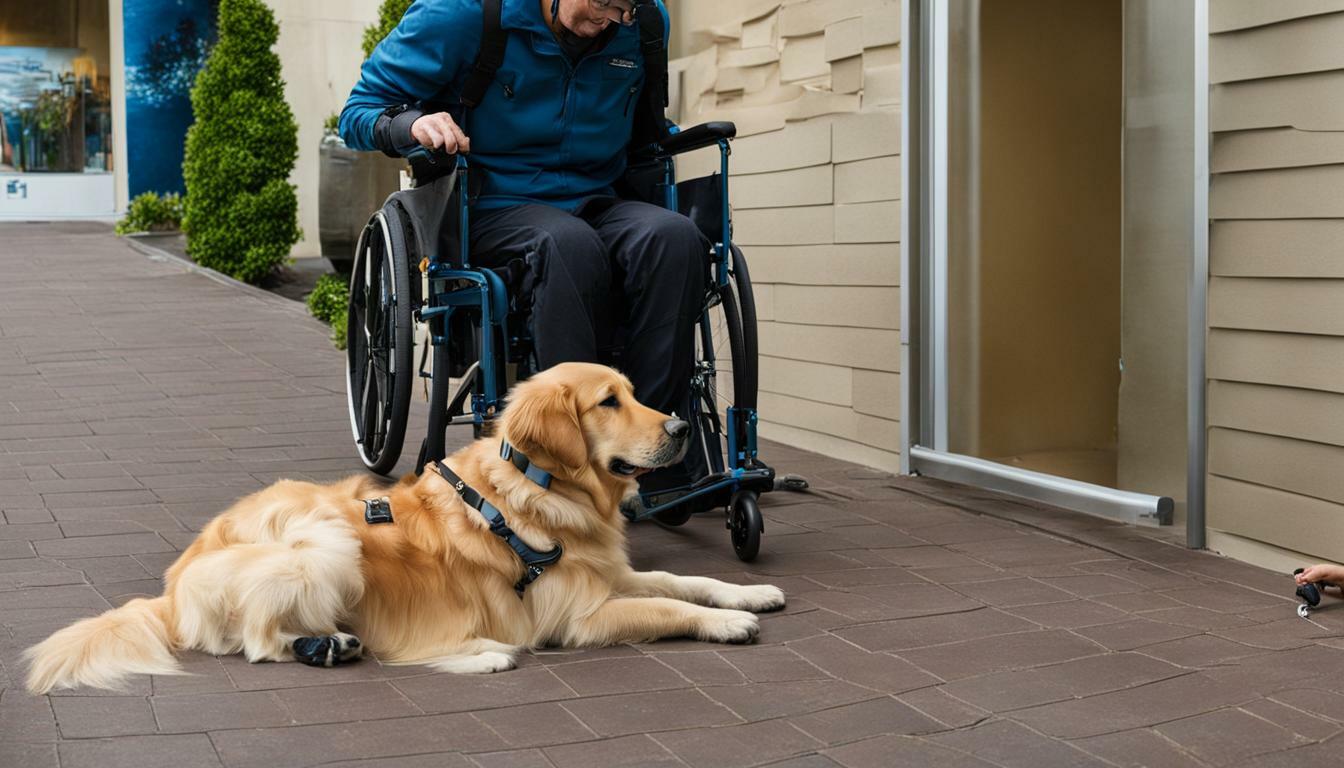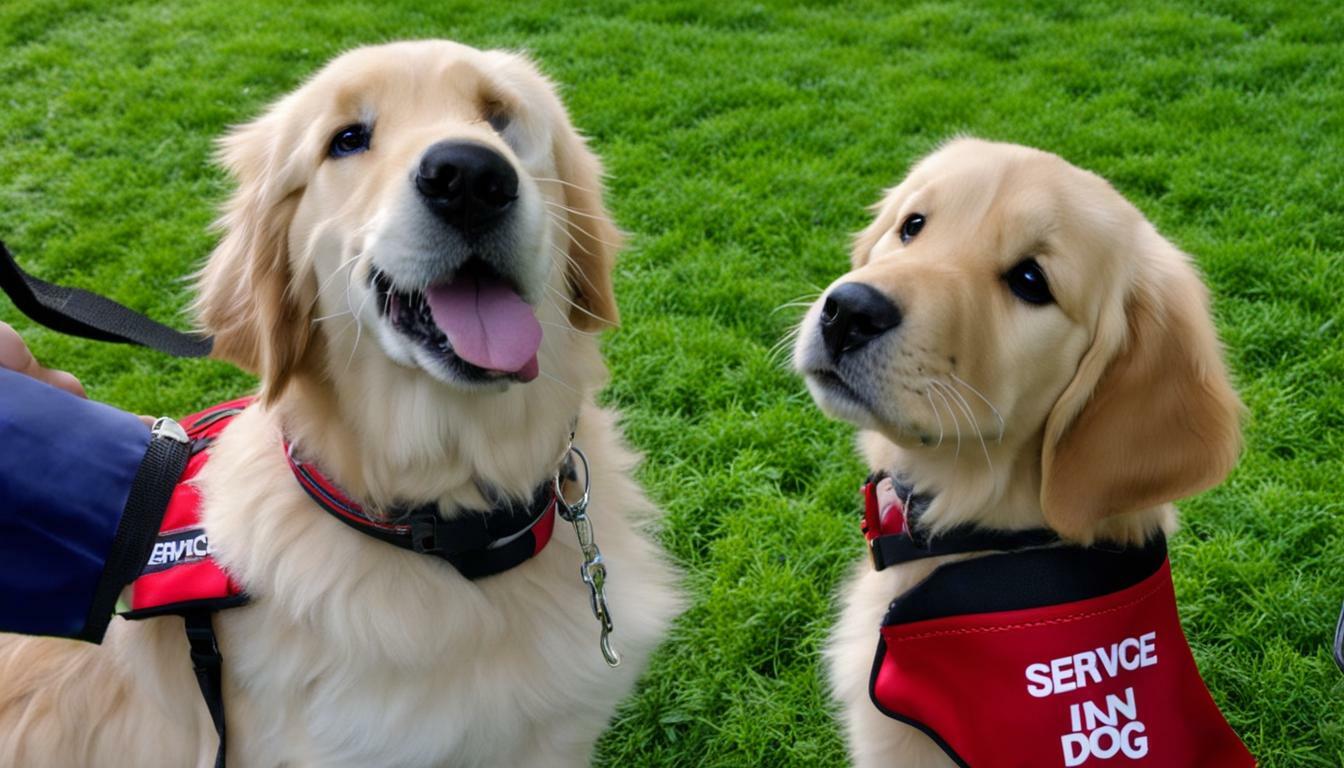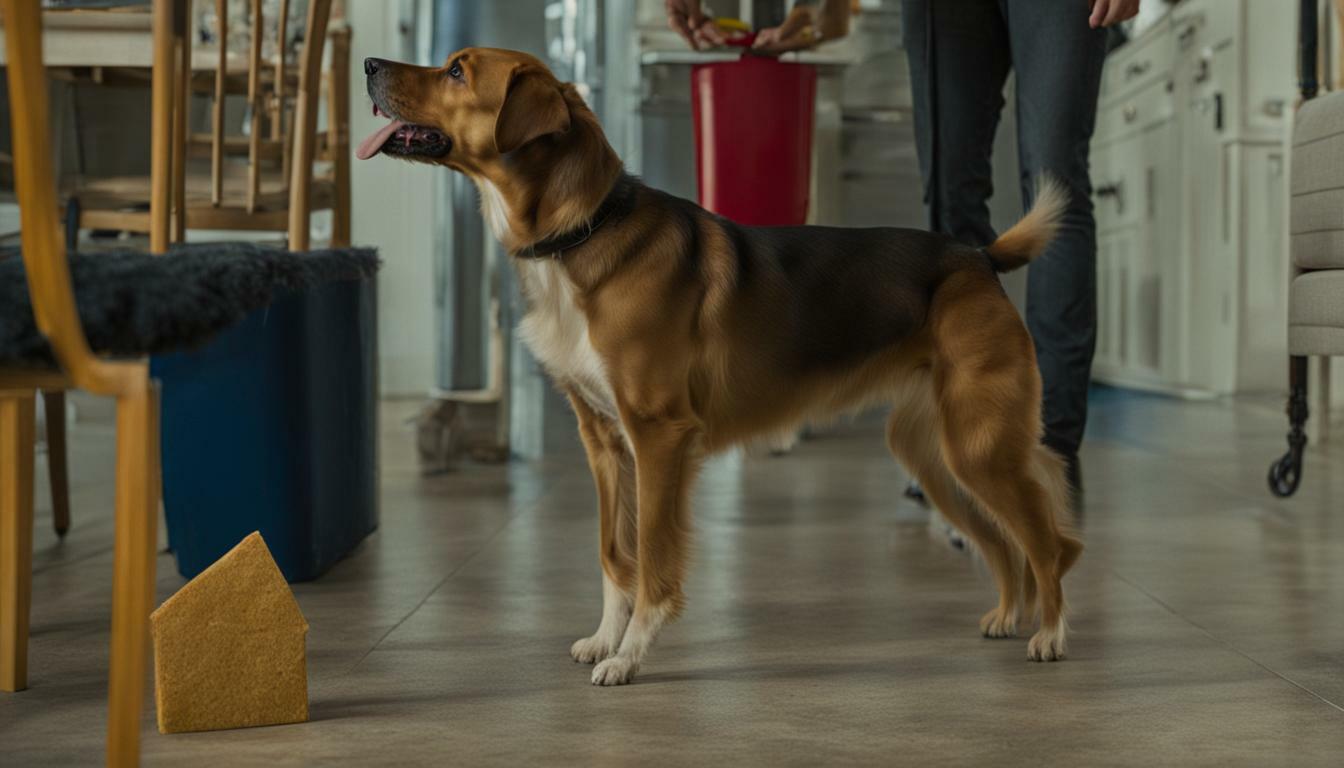Training your dog to become a service dog is a rewarding and challenging journey that requires patience, dedication, and consistency. Service dogs provide invaluable assistance to individuals with disabilities, helping them navigate the world and perform tasks that may otherwise be impossible.
In this comprehensive guide, we will provide you with a step-by-step approach to training your dog to become a service dog. From understanding the basics of service dog training to advanced techniques, this guide will equip you with the knowledge and tools needed to successfully train your dog to assist individuals with disabilities. We will also explore the process of obtaining service dog certification and the different tasks that a service dog can perform.
- Training a service dog requires patience, dedication, and consistency.
- A service dog can perform tasks that help individuals with disabilities navigate the world.
- Service dog training involves understanding the basics and advanced techniques, as well as obtaining certification.
- Training a service dog is a rewarding journey that can make a positive difference in someone’s life.
Understanding Service Dogs and Their Role
Service dogs have a critical role in our society, providing assistance to individuals with disabilities and helping to enhance their quality of life. These highly trained dogs are capable of performing a variety of tasks, from guiding the blind to alerting the deaf, and even detecting medical emergencies such as seizures.
Train a dog to be a service dog requires a significant investment of time, effort, and resources, but the rewards of having a loyal, dedicated companion who can assist you in your daily life are immeasurable. Service dogs are typically trained to perform a range of tasks, including providing mobility assistance, retrieving dropped items, and alerting their handlers to important sounds, such as smoke alarms or doorbells.
Training a service dog is a complex process involving a range of specialized techniques and methods. It requires a high level of consistency, patience, and attention to detail to ensure that the dog is trained to the highest standards.
Service dog tasks can be divided into two broad categories: physical tasks and emotional support tasks. Physical tasks are those tasks that involve physical action, such as retrieving objects, opening doors, and providing balance support. Emotional support tasks, on the other hand, involve providing comfort, companionship, and emotional support to individuals with disabilities.
Whether you are training a dog for yourself or for a client, it is essential to understand the role of service dogs in our society and the specific tasks they are trained to perform.
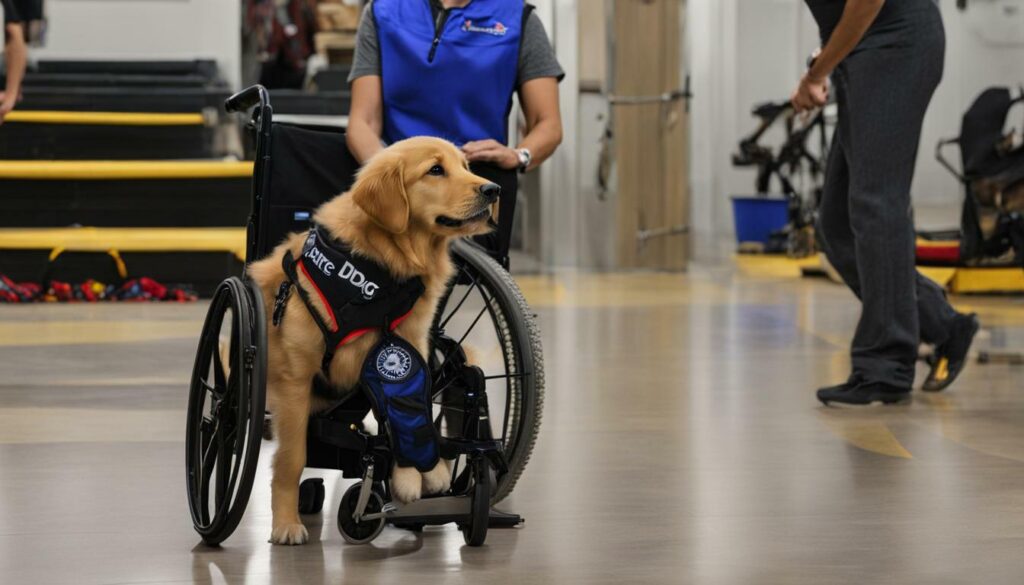
Service dogs are highly trained animals that provide critical assistance to individuals with disabilities. They are trained to perform a range of tasks, from guiding the blind to alerting the deaf and even detecting medical emergencies such as seizures.
One of the most critical aspects of service dog training is teaching the dog to perform specific tasks on command. This requires a high level of training and conditioning, as well as the ability to communicate effectively with the dog.
Service dog certification is an essential part of the training process, as it ensures that the dog is properly trained and qualified to perform its duties. This certification can only be obtained through an accredited service dog organization or program, and it typically involves rigorous training and testing.
Overall, service dogs play a crucial role in our society, providing invaluable assistance to individuals with disabilities and helping to improve their quality of life. By understanding the role of service dogs and the specific tasks they can perform, you can better appreciate the important work that these animals do.
Evaluating Your Dog’s Suitability for Service Dog Training
Before embarking on service dog training, it is essential to evaluate your dog’s suitability for this role. Not all dogs possess the necessary temperament, health, and obedience to become a service dog. Evaluating your dog prior to starting official training can save you time, money, and effort.
Dog behavior training is the first step in determining your dog’s suitability for service dog training. Your dog should be well-behaved, calm, and confident. They should neither be aggressive nor fearful towards humans or animals. If your dog exhibits any aggression or fearfulness, it is crucial to address these issues before starting service dog training.
Service dog training requires dogs to perform specific tasks, and they should also possess certain physical abilities. For instance, service dogs should be physically fit, and their size should be suitable for the tasks they will perform. For example, a Great Dane may not be an appropriate choice for tasks that require a small dog’s agility.
Dog obedience training is another crucial aspect to consider. A service dog must be obedient and responsive to commands. Basic obedience training should be mastered before starting official service dog training. Your dog should be able to sit, stay, come, and walk on a leash without pulling.
Evaluating your dog’s suitability for service dog training can take time. You should observe your dog’s behavior in different environments and situations, such as around other people and dogs, in crowded places, and while encountering distractions. You may also want to consult with a professional dog trainer or veterinarian to assess your dog’s suitability for service dog training.
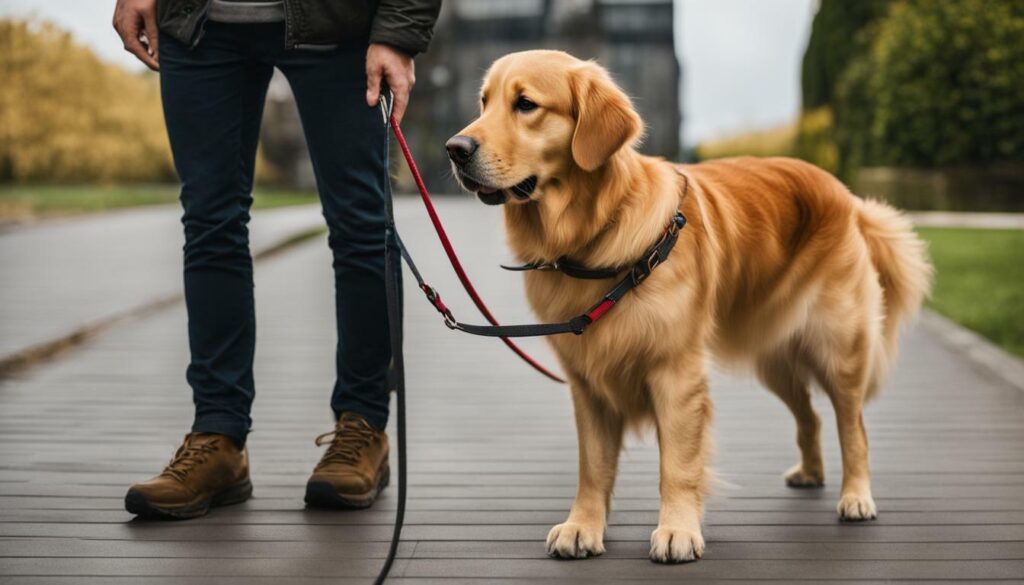
A service dog’s temperament is one of the most important factors to consider when evaluating your dog’s suitability for this role. A service dog should possess qualities such as patience, obedience, confidence, and a calm demeanor. A dog that is anxious, fearful, or aggressive would not be appropriate for service dog training.
During the evaluation process, observe how your dog interacts with other people and animals. Pay attention to their body language and reactions to different situations. Your dog should be comfortable in crowded places, around loud noises, and in public settings. They should also be able to perform tasks without becoming distracted or agitated.
Assessing Your Dog’s Health
Service dogs must be physically fit and healthy. They may be required to perform tasks that require physical exertion, such as opening doors or carrying items. Your dog should be free from any health conditions that may affect their ability to perform these tasks.
Before starting service dog training, ensure that your dog is up to date on their vaccinations and has received a comprehensive physical exam. You should also consult with your veterinarian to determine your dog’s suitability for service dog training based on their health history.
Addressing Behavioral Issues
If your dog exhibits any behavioral issues, such as aggression, fearfulness, or separation anxiety, it is essential to address these issues before starting service dog training. Behavioral issues can make it challenging for your dog to perform tasks and jeopardize their safety and the safety of those around them.
Consult with a professional dog trainer to address any behavioral issues your dog may have. A professional trainer can provide you with guidance on how to modify your dog’s behavior and teach them appropriate responses to different situations.
Basic Obedience Training for Service Dogs
Before beginning advanced service dog training, your dog must have a strong foundation in basic obedience. Basic obedience training will help develop your dog’s attentiveness, impulse control, and responsiveness. The following are key obedience commands that a service dog should master:
| Command | Description |
|---|---|
| Sit | Teaching your dog to sit on command is the first step in obedience training. Start by holding a treat above your dog’s head and saying “sit.” Slowly move your hand back over your dog’s head, and as they follow the treat, their bottom will naturally lower to the ground. Once they sit, give them the treat and praise them. |
| Stay | The “stay” command will teach your dog impulse control and patience. Start by telling your dog to “sit.” While your dog is sitting, raise your hand and say “stay.” Then step back one step and wait a few seconds before returning to your dog and praising them. Gradually increase the distance and duration of the “stay” command. |
| Heel | The “heel” command teaches your dog to walk calmly beside you without pulling on their leash. Start by holding your dog’s leash with both hands and standing to their left side. Say “heel” and begin walking. If your dog pulls, stop walking and wait for them to stop pulling. Once they stop, praise them and continue walking. |
| Down | The “down” command teaches your dog to lie down on command. Start by placing your dog in a sitting position. Hold a treat in front of their nose and slowly move it towards the ground. As your dog follows the treat, their elbows will touch the ground. Once they are lying down, give them the treat and praise them. |
| Come | The “come” command is essential for ensuring your dog’s safety and readiness to assist. Start by standing a few feet away from your dog and calling their name, followed by “come.” When they come to you, give them a treat and praise them. Gradually increase the distance between you and your dog until they come to you from any distance. |
Consistency is key in basic obedience training. Repeat the commands daily in short sessions and use positive reinforcement to reward good behavior. Once your dog has mastered basic obedience, you can move on to advanced service dog training techniques.
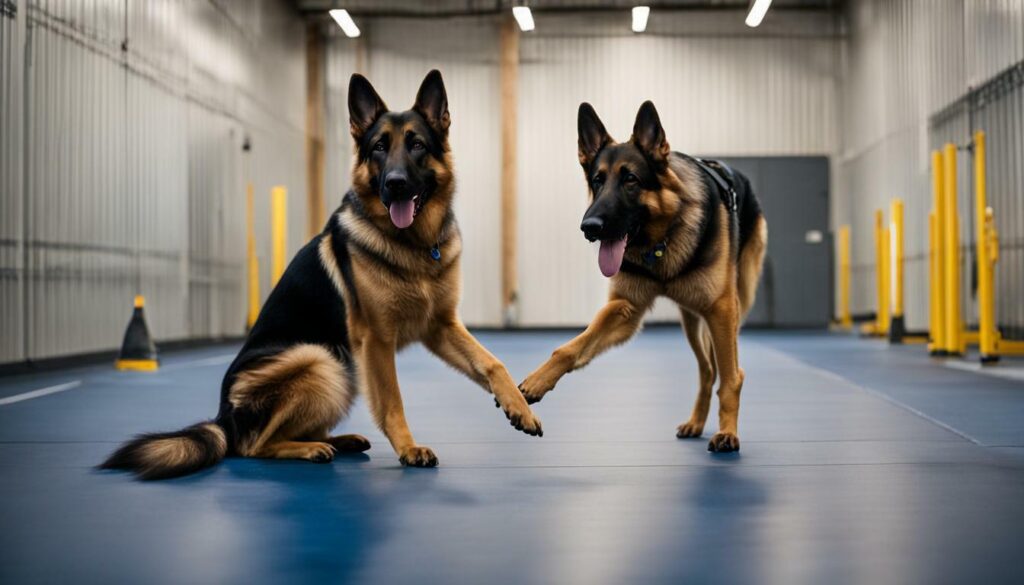
Once your dog has mastered basic obedience, it’s time to move on to more advanced training techniques. Advanced training will involve teaching your dog specific tasks that are tailored to their handler’s needs. These tasks can range from opening doors to retrieving specific objects, depending on the handler’s specific needs.
One of the most crucial aspects of advanced service dog training is task training. This involves identifying tasks that your dog can perform to assist their handler and teaching them how to do it efficiently and safely. Tasks must be personalized to meet the needs of the specific handler, and the training process may take several weeks or months to accomplish.
Public access training is another essential aspect of advanced service dog training. It involves teaching your dog how to behave appropriately in various public settings, such as restaurants, malls, and public transportation. Your dog must learn to stay calm and focused in these settings while performing their tasks effectively.
Scent discrimination training is also an important aspect of advanced service dog training. The dog can be trained to detect specific scents, such as allergens, low blood sugar, or even cancer, and alert their handler when they encounter the scent. This training requires a lot of time, patience, and consistency.
It’s important to remember that advanced service dog training is a gradual process that requires a lot of effort and time from both you and your dog. It’s essential to work at a pace that is comfortable for your dog to prevent burnout and frustration.
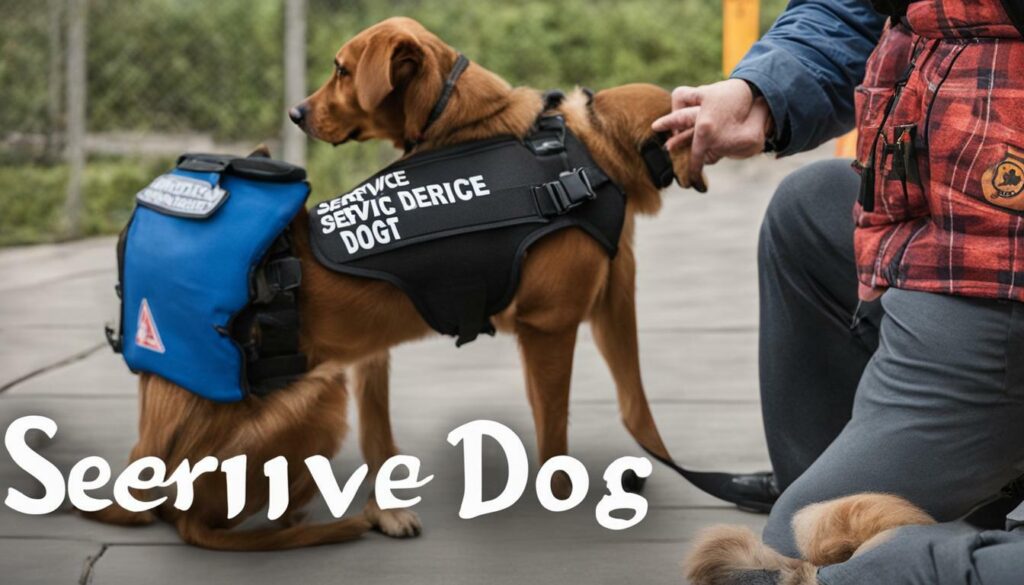
Section 6: Socializing Your Service Dog
Socialization is a critical aspect of service dog training. It involves exposing your dog to different people, animals, environments, and situations in a positive and controlled manner. Socialization is crucial for creating a well-rounded service dog that is calm, confident, and adaptable in all situations.
During the early stages of your dog’s life, it is essential to expose them to as many positive experiences as possible. This exposure helps your dog develop a positive outlook towards the world and reduces the likelihood of developing anxiety or fear.
The training process should be gradual, and you should introduce new experiences and environments slowly. Start with controlled environments such as your home and backyard and gradually progress to more complex environments such as busy streets or crowded public transportation.
When introducing your dog to new people, make sure they approach your dog calmly and gently. This helps your dog feel more comfortable around strangers and reinforces positive behavior. You should also expose your dog to different types of people, including children, the elderly, and individuals with disabilities.
Additionally, socializing with other animals is essential for a service dog. Introducing your dog to other dogs and animals in a controlled environment helps it learn how to interact appropriately with other animals. It also helps reduce the likelihood of aggression towards other animals.
You should also expose your dog to different types of environments, including parks, shops, and other public places. This helps your dog learn how to behave appropriately in different settings and adapt to any situation they may encounter.
Overall, the socialization process is an essential part of your dog’s training. It helps create a well-rounded service dog that can handle any situation with confidence and ease.
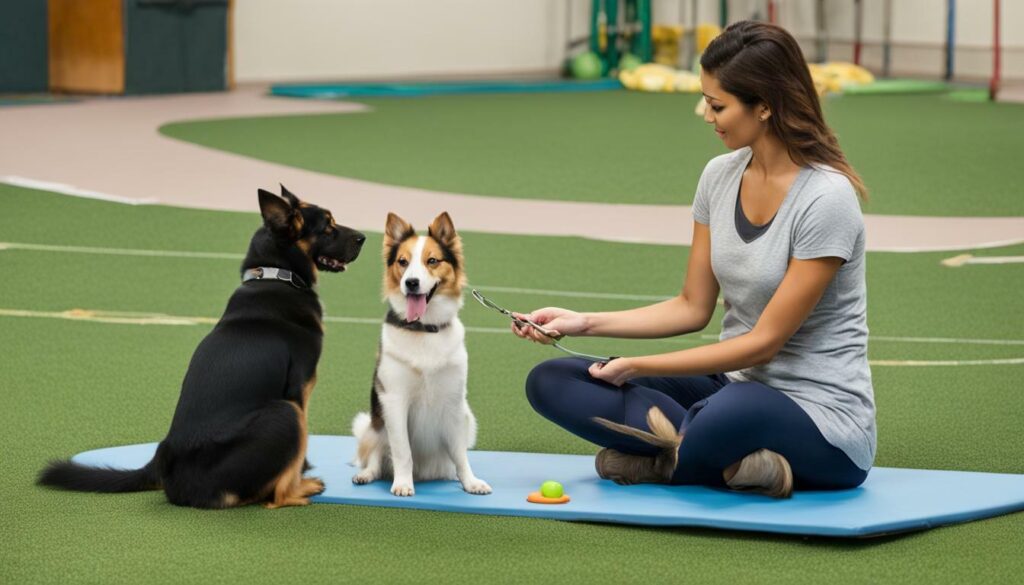
Proper socialization is a crucial aspect of service dog training. By exposing your dog to different people, animals, and environments, you can help create a well-rounded service dog that is calm, confident, and adaptable in all situations. Remember to take the socialization process slowly and introduce new experiences gradually. With patience and dedication, you can help your service dog become a valuable companion and helper for individuals with disabilities.
Service Dog Handler Training
Training a service dog is not just about the dog; it also involves training the handler. A service dog handler must learn to communicate effectively with their dog, navigate public spaces, and understand their legal rights and responsibilities.
One of the key aspects of service dog handler training is building a strong bond with your dog. This includes developing trust and understanding your dog’s behavior and body language. Effective communication is also crucial; a handler must be able to give clear commands and signals to their dog and recognize when their dog needs assistance or is experiencing stress.
Handlers must also be knowledgeable about the laws and regulations surrounding service dogs. This includes understanding their legal rights and responsibilities, as well as the rights of other individuals and entities. It is important for handlers to be able to advocate for themselves and their dogs in situations where their rights are being infringed upon.
Proper handling techniques are also crucial for the safety and effectiveness of a service dog team. Handlers must learn to handle their dog in a way that is appropriate for their tasks and environment, including managing any equipment or gear that the dog may wear.
Overall, service dog handler training is essential for the success of a service dog team. It requires dedication, patience, and a willingness to learn and grow with your dog.

Obtaining proper certification for your service dog is critical to ensure their access to public places and legal protection. In the United States, service dogs are protected under the Americans with Disabilities Act (ADA), which prohibits discrimination against individuals with disabilities and their service animals.
To obtain certification for your service dog, you must first ensure that your dog meets the criteria for a service animal. According to the ADA, a service animal is defined as a dog that is trained to perform specific tasks for a person with a disability. Emotional support or therapy dogs are not considered service animals under the ADA.
Once you have determined that your dog qualifies as a service animal, you can obtain certification through a variety of organizations. However, it’s important to note that there is no official certification or registry in the United States for service dogs. Certification from a reputable organization can still be beneficial as it may provide additional training resources and could help in situations where your dog’s status as a service animal is questioned.
In addition to obtaining certification, it’s essential to understand the legal considerations and rights associated with owning a service dog. These include the right to bring your service dog into public places, including restaurants, hotels, and other establishments. However, it’s important to note that your service dog must be well-behaved and under your control at all times.
If you encounter any challenges or discrimination with regards to your service dog, it’s important to know your rights and seek legal assistance if necessary. Overall, obtaining proper certification and understanding the legal considerations and rights associated with owning a service dog is crucial for ensuring your dog’s ability to perform their tasks and assist you in your daily life.
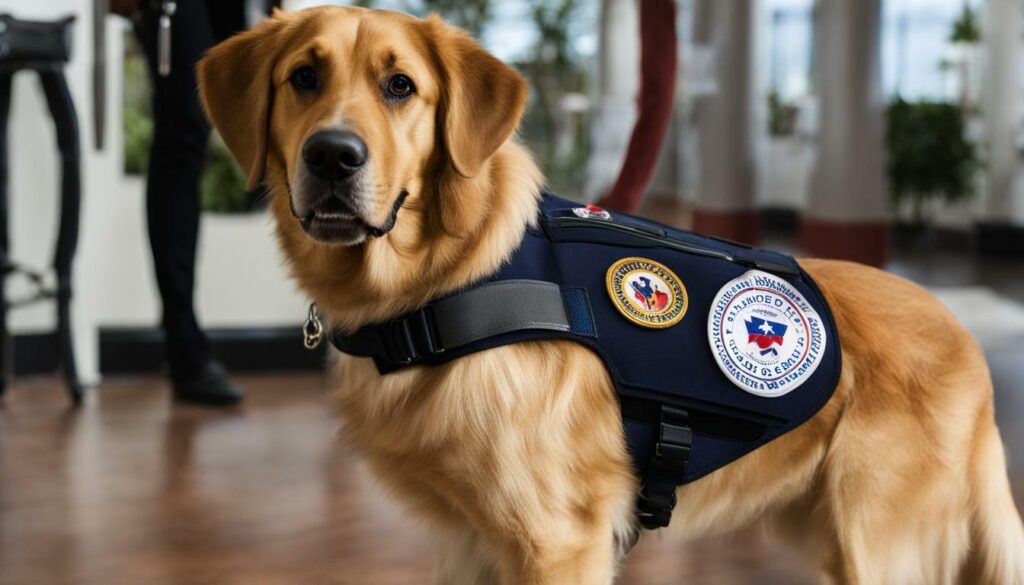
Training a Therapy Dog vs. Training a Service Dog
While both therapy dogs and service dogs play important roles in supporting people with disabilities, their training and tasks differ significantly. Therapy dogs are trained to provide comfort and affection to people in hospitals, nursing homes, schools, and other settings. They are not legally protected as service dogs and do not have public access rights unless they are invited to a specific location.
Service dogs, on the other hand, are trained to perform specific tasks that help people with disabilities live independently. They are legally protected and have public access rights and can accompany their handlers to places such as restaurants, stores, and public transportation. Service dogs’ tasks may include guiding people who are blind, alerting people who are deaf, retrieving items, providing balance support, and performing other tasks specific to their handler’s needs.
When it comes to training, therapy dogs typically undergo basic obedience training and temperament testing to ensure they are friendly and well-behaved in public settings. They may also receive specialized training, such as learning to tolerate medical equipment, loud noises, and other stressors commonly found in hospitals and nursing homes.
Service dogs, on the other hand, undergo rigorous and specialized training to perform their tasks reliably and safely. The training process is typically longer and more intensive than therapy dog training, as service dogs need to learn complex tasks and behaviors that require concentration, intelligence, and problem-solving skills. Additionally, service dogs must be well-behaved in public and trained to ignore distractions such as other people, animals, and smells.
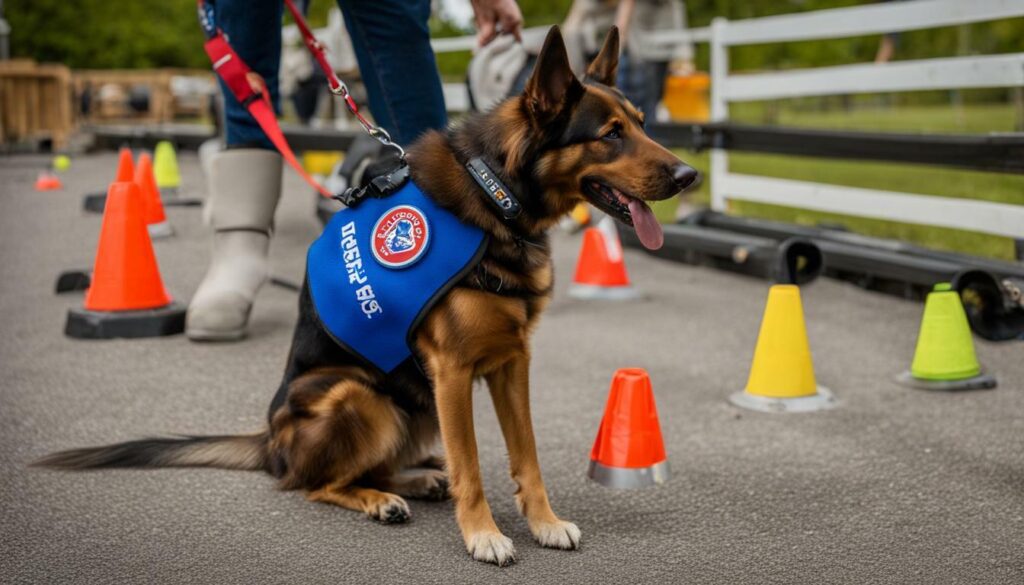
Training a therapy dog versus a service dog requires different approaches and techniques, but both require a significant amount of time, effort, and patience. It’s important to understand the distinction between these two types of dogs and choose the path that best aligns with your goals and your dog’s temperament and abilities.
Maintaining a Service Dog’s Training and Skills
Training a service dog is an ongoing process that requires dedication and consistency. Once your dog has completed their initial training, it’s essential to continue reinforcing their skills and maintaining their proficiency in performing specific tasks. Here are some tips for maintaining your service dog’s training and skills:
Regular Practice
Practice makes perfect, and this couldn’t be truer for service dogs. Regular practice sessions will help reinforce your dog’s training and ensure that they remain proficient in performing their tasks. Make sure to schedule regular practice sessions throughout the week and maintain consistency in your training techniques.
Reinforcement
Positive reinforcement is vital in maintaining your service dog’s training. Reward your dog with treats, praise, and affection every time they perform a task correctly. Consistently rewarding your dog will help reinforce their training and motivate them to perform their tasks correctly.
Continuing Education
Continuing education is essential for keeping up-to-date with the latest service dog training techniques. Attend seminars, workshops, and training sessions to learn new skills and stay current with best practices. Continuing education will not only benefit your service dog but also improve your handling skills.
Regular Health Checkups
A healthy service dog is a happy service dog. Regular visits to the veterinarian will help ensure that your dog remains in good health and is capable of performing their tasks. Make sure to schedule regular checkups and vaccinations as recommended by your veterinarian.
Stay Consistent
Consistency is key to maintaining your service dog’s training and skills. Stick to a routine that works for you and your dog and maintain consistency in your training techniques and reinforcement methods. This will help reinforce your dog’s training and ensure that they remain proficient in performing their tasks.
By following these tips, you can ensure that your service dog remains proficient in performing their tasks and continues to make a positive impact in the lives of those in need.

It is important to remember that service dogs are not pets, but rather highly trained working animals that assist individuals with disabilities. They play a critical role in their handlers’ lives and deserve respect and consideration from the public.
When encountering a service dog team in public, it is important to remember the following etiquette:
- Do not approach or pet the service dog without the handler’s permission.
- Avoid making loud noises or sudden movements that could startle the dog.
- Do not offer the dog food or treats, as they are on a strict diet.
- Do not attempt to distract the dog from their task.
It is also important to understand the legal rights and limitations of service dogs. In the United States, service dogs are protected under the Americans with Disabilities Act (ADA) and are allowed access to public places such as restaurants, stores, and public transportation. Service dogs are allowed to accompany their handlers wherever they go, and it is illegal to deny access to a service dog team unless the dog is out of control or poses a direct threat to the safety of others.
However, it is important to note that emotional support animals and therapy dogs are not considered service dogs under the ADA and do not have the same legal rights of access. It is essential to respect the distinction between these types of dogs and their roles in assisting individuals with disabilities.
By promoting public awareness and understanding of service dogs, we can create a more inclusive and welcoming environment for individuals with disabilities.
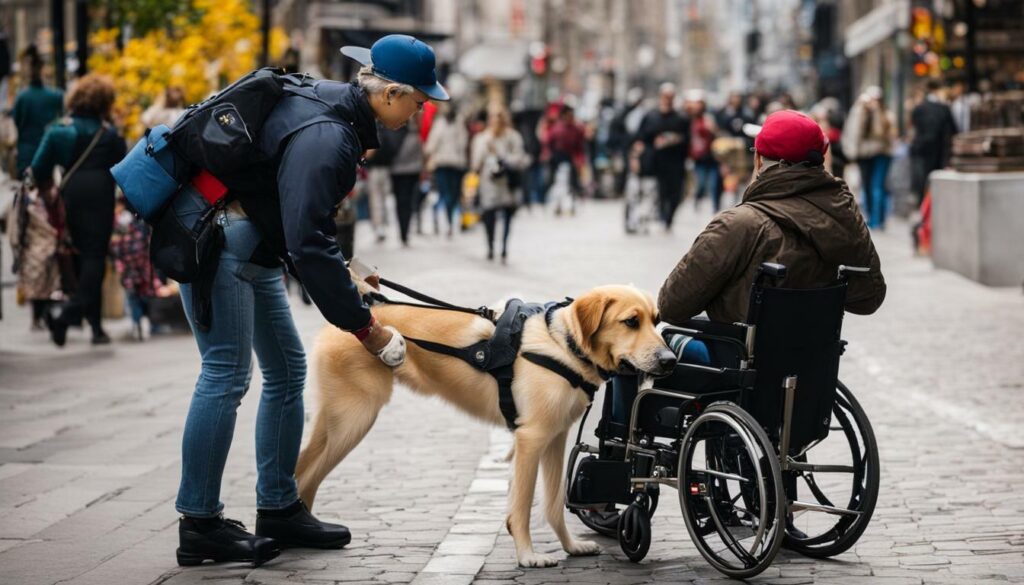
A service dog’s health and well-being are crucial for their ability to perform their duties. As a handler, you are responsible for ensuring that your dog receives proper nutrition, exercise, grooming, and veterinary care. A well-cared-for service dog is more alert, focused, and better able to perform their tasks.
Proper nutrition is essential for maintaining your service dog’s health. A balanced diet that includes high-quality protein, fats, and carbohydrates can help support their energy levels, immune system, and overall well-being. Consult with your veterinarian to determine the best diet for your service dog based on their individual needs.
Regular exercise is also important for your service dog’s physical and mental health. It can help improve their cardiovascular health, maintain muscle tone, and reduce stress. Incorporate daily exercise into your service dog’s routine, such as taking them for walks, playing fetch, or practicing obedience training.
Grooming is another essential aspect of maintaining your service dog’s health. Regular brushing, bathing, and nail trimming can help prevent skin infections, matting of fur, and overgrown nails. It is also essential to check your service dog’s ears, eyes, and teeth regularly for signs of infection or decay.
Regular veterinary care is crucial for ensuring your service dog’s overall health and well-being. Schedule routine check-ups with your veterinarian and keep up-to-date on vaccinations and parasite prevention. Also, be sure to monitor your service dog’s behavior and energy levels for any signs of illness or injury and seek veterinary care immediately if necessary.

By prioritizing your service dog’s health and well-being, you can ensure that they are ready and able to perform their duties as a service dog. Regular exercise, proper nutrition, grooming, and veterinary care can help keep your service dog healthy and happy throughout their working life.
Troubleshooting Common Challenges in Service Dog Training
Training a service dog can present unique challenges, and it’s essential to be prepared for potential roadblocks along the way. Below are some common challenges that service dog handlers may encounter during the training process:
| Challenge | Troubleshooting Tips |
|---|---|
| Fear or Anxiety | Take a step back and assess the situation. Determine what may be causing the fear or anxiety and work on desensitizing your dog to those triggers. Start small and gradually increase exposure as your dog becomes more comfortable. |
| Distractions | Practice training in different environments with increasing distractions. Gradually increase the distractions and work on reinforcing focus and attention on the task at hand. Use positive reinforcement to reward good behavior. |
| Aggression or Reactivity | Address aggression or reactivity issues with a professional dog trainer or behaviorist. Determine the root cause of the behavior and work on a training plan to modify the behavior. |
| Health Issues | Regular veterinary care is essential for service dogs. If your dog is experiencing health issues that are affecting their training or performance, seek medical treatment and adjust training accordingly. |
It’s important to be patient and consistent when troubleshooting challenges during service dog training. Seek professional guidance when needed and remember to celebrate both yours and your service dog’s progress along the way.
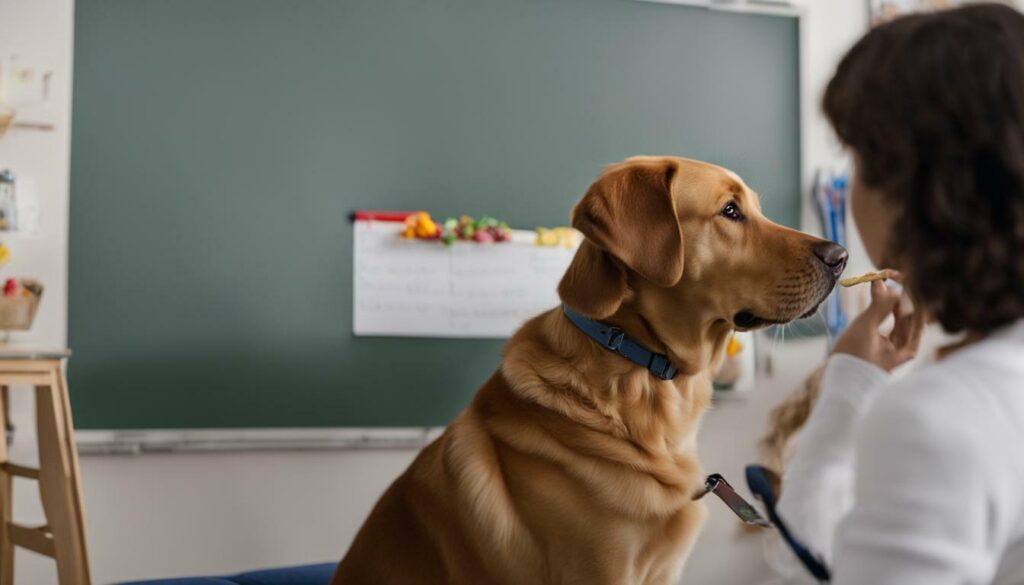
Congratulations – you have completed the comprehensive guide on how to train your dog to become a service dog. We hope that this guide has provided you with the knowledge and tools needed to successfully train your dog to assist individuals with disabilities.
The journey of training a service dog is fulfilling and rewarding, but it can also be challenging. Remember to approach the training process with patience, consistency, and dedication. Every dog is unique, and progress may not always be linear, but with persistence, you can achieve your goals.
Celebrating Achievements
It is important to celebrate the milestones and achievements reached during the service dog training process. Take time to acknowledge the hard work and progress made, both by you and your furry friend. Celebrate your dog’s successful completion of training tasks, and cherish the moments where they demonstrate their ability to assist individuals with disabilities.
Remember that the journey doesn’t end once your dog has completed their training and obtained certification. Maintaining your dog’s training and skills is crucial to ensuring their continued success as a service dog.
Continuing Education
As you embark on this journey, remember to seek out resources for continued education. Attend workshops, classes, or seminars on service dog training to stay up-to-date with the latest techniques and training methods. Connect with other service dog handlers to share experiences and gain insights into best practices.
Conclusion
Training a service dog is a journey that requires dedication, patience, and perseverance. We hope that this guide has equipped you with the knowledge and tools needed to train your dog to assist individuals with disabilities. Remember to celebrate the milestones and achievements reached during the training process and to continue your education to maintain your dog’s skills and success.
With a well-trained service dog by your side, you can make a positive difference in the lives of those in need. Good luck on your journey!
FAQ
What is the purpose of this guide?
This guide is designed to provide step-by-step instructions and information on how to train your dog to become a service dog. It covers everything from basic obedience training to advanced techniques and the process of obtaining service dog certification.
What tasks can a service dog perform?
Service dogs can be trained to perform a variety of tasks, depending on the needs of the individual they are assisting. Some common tasks include guiding individuals with visual impairments, alerting to sounds for those with hearing loss, providing stability and balance for individuals with mobility challenges, and retrieving items for individuals with physical disabilities.
How do I determine if my dog is suitable for service dog training?
Before starting service dog training, it’s important to evaluate your dog’s temperament, health, and obedience. This will help determine if they have the potential to succeed as a service dog. It’s also important to address any behavioral issues your dog may have before starting official training.
What are the basic obedience commands for service dogs?
Some essential basic obedience commands for service dogs include sit, stay, come, down, and heel. These commands form the foundation for more advanced training and are crucial for a well-behaved service dog.
What are some advanced service dog training techniques?
Advanced service dog training techniques include task training, which involves teaching your dog to perform specific tasks to assist individuals with disabilities. Other techniques include public access training to help your dog navigate various environments confidently and scent discrimination training for tasks such as alerting to medical conditions.
Why is socializing my service dog important?
Socializing your service dog from an early age is crucial to their development. It helps them become comfortable in different environments, around various people and animals, and prepares them to handle new situations. Proper socialization ensures that your service dog is well-rounded and confident.
What is service dog handler training?
Service dog handler training involves teaching the individual who will be working with the service dog how to effectively communicate and interact with their dog. It also includes understanding legal rights and responsibilities associated with owning a service dog and practicing proper handling techniques.
How do I obtain service dog certification?
Obtaining service dog certification involves meeting specific documentation and training requirements. The process may vary depending on your location and the organization issuing the certification. It’s important to research the certification requirements in your area and work with a reputable organization.
What is the difference between training a therapy dog and a service dog?
Therapy dogs and service dogs serve different purposes. Therapy dogs are trained to provide comfort and support to individuals in various settings, such as hospitals or nursing homes. Service dogs, on the other hand, are trained to perform specific tasks to assist individuals with disabilities. The training requirements and tasks performed by each type of dog differ.
How do I maintain my service dog’s training and skills?
Maintaining your service dog’s training and skills requires regular practice, reinforcement, and continuing education. Consistency is key in ensuring that your service dog remains proficient in their tasks and obedient in various situations.
What is service dog etiquette?
Service dog etiquette refers to the proper behavior and interactions when encountering a service dog team. It involves understanding the rights and limitations of service dogs, refraining from distracting or interfering with them while they are working, and promoting public awareness and acceptance of service dogs.
How do I ensure the health and well-being of my service dog?
Ensuring the health and well-being of your service dog involves providing proper nutrition, exercise, grooming, and regular veterinary care. It’s essential to monitor your dog’s overall health and address any signs of stress or burnout. Taking care of your service dog’s physical and mental well-being is crucial for their ability to perform their duties.
What do I do if I encounter challenges during service dog training?
If you encounter challenges during service dog training, it’s important to troubleshoot and find solutions. Common challenges may include fear and anxiety, distractions, or difficulty with specific tasks. Consulting with a professional trainer or behaviorist can help address these challenges and keep your training progress on track.
What should I keep in mind as I celebrate my service dog’s journey?
Celebrating your service dog’s journey requires recognizing the hard work, dedication, and patience involved in their training. By completing this comprehensive guide, you have equipped yourself with the knowledge and skills to make a positive difference in the lives of those in need. Embrace the rewarding journey of training a service dog and continue to support their ongoing development.
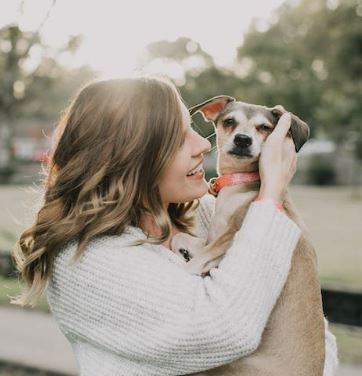
Marissa Delotta, 36, from Dayton, Ohio, is the creative force behind Roverboard.com, a beloved online destination for dog lovers. As a dedicated mom and canine enthusiast, Marissa combines her family experiences with her love for dogs to offer a platform where dog owners can exchange tips, heartwarming stories, and advice. Her website has become a vibrant community for sharing the joys of dog parenting. In her free time, Marissa enjoys exploring dog parks with her family and volunteering at local animal shelters.

